GM used to sell two slightly different versions of the same thing – the Pontiac Firebird and the Chevrolet Camaro. It was done that way because GM’s Pontiac and Chevrolet divisions both needed a sporty car in their respective lineups and the thought was it’d be less expensive (and so more profitable) to design one car and sell it two ways.
A similar dynamic is operative with regard to the Toyota GR86 and the Subaru BRZ – with the difference being Toyota and Subaru are two different car companies.
So why are they selling the same car under their respectively different labels? For pretty much the same reason – except now it’s the government that’s making it more expensive (and so, less profitable) for car companies to make their own sports cars.
Or – for that matter – their own engines and transmissions.
The 86 is a two-door, four-seat, rear-wheel-drive sport coupe that is basically the same car as the Subaru BRZ. Both are powered by the same Subaru drivetrain and share most of their exterior panels, with a few styling tweaks to differentiate them.
So – why buy one over the other?
Some may prefer a Toyota – even if it’s actually a Subaru under the skin. And some would rather a Subaru sold as one.
Also, there are some minor suspension tuning differences – very similar to the differences, back in the day, between a Camaro and Firebird. The Toyota (like the Chevy) has a slightly firmer ride than the Subaru (and the Pontiac).
There are pricing differences, too.
The Toyota version of this sports car stickers for $28,300 to start while the same basic car with a Subaru badge lists for $30,195.
A top-of-the-line Trueno (MSRP $29,300) comes with upgraded Brembo brakes, SACHS dampers and a set of 18×7.5 inch matte black wheels with high-performance summer tires, plus Black Trueno Edition side strips, hood wrap and red leather seat accents. The Trueno is only available in two exterior colors – Halo white or Track Red and is limited to 860 examples, each of which gets a serialized dash plaque.
The Subaru BRZ is available with similar equipment in its top-of-the-line tS version, which lists for $35,345.
Both are slightly larger, more practical (those back seats) alternatives to the two-seater Mazda Miata, which is reviewed here.
What’s New For 2024
In addition to the limited-edition Trueno Edition, there’s also a new a performance package that’s available for all trims. It includes the upgraded brakes, SACHS dampers and more aggressive wheel/tire package that comes standard with the Trueno.
The “driver assistance technology” – including Lane Departure Assist – that was previously optional is now standard in all trims. 
What’s Good
Back seats make up for small trunk.
Hardtop for those who don’t want a soft-top.
The only boxer-engined sports car available for less than just shy of $70k (the price of a new Porsche Cayman).
What’s Not So Good
Hardtop only will disappoint those who want a soft-top.
Significantly thirstier than the Miata.
“Driver assistance technology” is now unavoidable.
Both the G86 and the BRZ have the same Subaru drivetrain, which consists of a 2.4 liter, horizontally opposed (boxer) four cylinder engine that makes 228 horsepower without a turbo. It does not need one, because the twins are light enough (about 2,800 lbs.) to be good performers with a naturally aspirated engine.
Each can get to 60 in about 5.4 seconds.
The boxer four is also an unusual type of engine in that no other car company offers this kind of engine – except for Porsche. Put another way, this is the only way to get a Boxer- engined sports car for less than just-shy of $70k.
Why does it matter? Is there anything wrong with an inline four such as the one that powers the Mazda Miata? Of course not. The Mazda’s 2.0 liter 181 horsepower four is revvy and sounds great when revved. But the Subaru’s growly boxer four sounds different than an inline four – and different is its own kind of better these days. There are some other – more objective – differences, too. The boxer-type engine sits lowers in the car, which gets its weight closer to the ground. Its weight is also evenly distributed on either side of the car’s centerline axis (front to rear) which aids balance.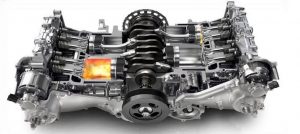
Another difference – vs. the Miata’s 2.0 liter in-line four – is power. The Subaru boxer engine makes significantly more. The downside – another difference – is that the Subaru boxer four is significantly thirstier, as previously mentioned. A GR86 rates 20 city, 27 highway; it also requires premium gas to deliver its peak advertised power. The Mazda’s four is a regular unleaded engine and rates 26 city, 34 highway, which is not far off the economy of economy cars and one of the reasons, probably, why the Miata has been a hot-seller since 1989. It’s as cheap to drive everyday – almost – as an economy car.
But it’s not an economy car.
The twins are less economical. But they are also more practical everyday drivers than the Miata – about which more follows below.
The boxer four is is paired with a standard six speed manual transmission, but an automatic is available for those who want one. It’s an $1,100 stand-alone option. Choosing the optional six speed automatic also bumps up the gas mileage a bit – to 21 city and 31 highway.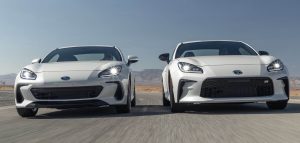
On The Road
Driving the GR86 vs. the Subaru BRZ is both the same and different – as it was in the ’80s and ’90s, when one drove a Chevy Camaro vs. a Pontiac Firebird. In both cases, the engines (and transmissions) are identical, so there’s no difference there. But there are differences in ride and handling, just as there were back then.
Like the Camaro, the GR86 has a firmer (even stiffer) ride than the BRZ, which has a ride more analogous to the Pontiac Firebird’s softer-than-Camaro suspension tuning. As it was back then, the tuning – of the ride and handling – is all that’s left for the engineers to tweak when the drivetrains are the same.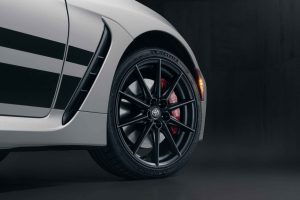
The long and short is as it was back then; the GR86 rides and feels more like a track-tuned car even though it isn’t grippier than the BRZ. It just feels like it is. This is great if you like the harder feel of a track-tuned car but the BRZ’s deceptively softer feel is a difference you may prefer. I test-drove a BRZ earlier this year (see here if interested in the review) and was surprised by how comfortable it was over the course of a long drive, when what matters is how your rear end and backside feel after a long drive. The combination of the softer suspension tuning and the supportive (but not rock-hard) sport seats worked together really well and reminded me of my Pontiac Trans-Am vs. the Z28 Camaros I’ve owned. Both great cars but the Pontiac version of GM’s pony car always had an easier-on-your-backside ride while still being just as adept at threading needles as the Z28.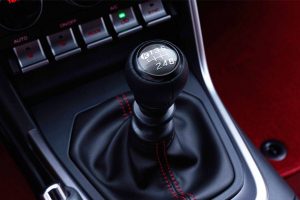
Both the GR86 and the BRZ feel stronger than the Miata – because they are. And because they are about the same weight as the Miata, which only weighs about 50 pounds less even though it is a smaller car and has only two seats. Probably because it’s a convertible and while the top doesn’t weigh much, the bracing that’s necessary to make up for the absence of the structure of a hardtop is.
The Mazda feels a little more personal – because it is. There’s just you and – at the most – one other person and you both sit closer together. Another difference is openness – and visibility. The Miata with its top down offers a panorama view of your surroundings. It’s like riding a motorcycle without a helmet and that is a big part of a roadster’s appeal – especially since you have to wear a helmet while riding a motorcycle in most states.
You feel more enclosed in the GR86/BRZ twins – because you are. Literally. The top does not drop. This imparts a less elemental feel. But also a more secure one that’s also more than just a feel – because a hardtop is literally more secure. The windows roll up tight and there’s no chance – unless you wreck – that the hardtop will not seal as tight in eight years from now as it does on the day you bought the car. Soft-tops are inherently more flexible because they have to be and over time that increases the chances of a looser fit – and leaks. Also, the soft-top when it’s up greatly reduces what you can see around you because of the fabric that limits what you can see.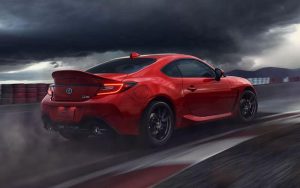
That said, the main everyday deficit of the twins vs. the Miata is arguably legs. Even though the GR86 and the BRZ carry significantly more fuel – 13.2 gallons vs. 11.9 for the Mazda – the Mazda can travel 309 miles in stop-and-go “city” driving – and 404 miles on the highway – before it needs a top-off vs. 264 miles in “city” driving and 356 on the highway for the twins.
A slightly larger tank that could hold an extra gallon or two would even things up and make the twins feel less thirsty than they are.
There are fewer cosmetic differences to differentiate the GR86 from the BRZ than there were, back in the day, between the Chevy Camaro and the Pontiac Firebird. People who geek out on this kind of thing know that, in fact, the only exterior panels that the Camaro and Firebird shared (during these cars’ heyday in the ’70s, when my Firebird was made) were the roof and the trunk lid. Everything else was slightly different and specific to the respective brand.
The differences that matter – today – are those vs. the twins’ only major rival, the Miata. We have already gone over the soft-vs.-hardtop differences. The other big difference is having four rather than just two seats. This is not so much a matter of having the capacity to at least hypothetically carry three rather than just one passenger, although that is not a small difference.
The bigger difference, arguably, is that the twins’ rear seats make up for the lack of capacity in the trunk. With the Miata, you have no choice but to pack light because whatever doesn’t fit in the little roadster’s 4.6 cubic foot trunk won’t fit anywhere else. With the twins, you get a larger (6.3 cubic foot) trunk to begin with and if what you need to carry won’t fit in there, you can always toss it in the rear, right behind you.
There’s also more room for your incidentals. The GR86 and BRZ both have gloveboxes; the Miata doesn’t. It has a tiny cubby built into the area behind and in-between the driver and passenger seat that is almost impossible to access while driving. The Miata also lacks cupholders. Or – rather – all it has are hilarious clip-on cupholders that you fasten precariously to either side of the center console, where they intrude into the already cozy space available.
The twins have fixed-in-place cupholders molded into a center console storage cubby in between the seats that is much easier to reach while driving.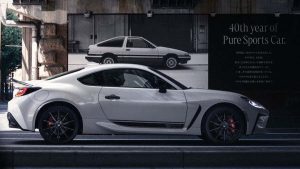
The Rest
One of the other differences between the Toyota and the Subaru are the options and packages each offers. The main one the Toyota is available with is the Limited Edition Trueno – which resurrects memories of the ’80s-era Corolla GT-S, which was called the Sprinter Trueno in Japan.
This version of the GR86 is visually very different from its Subaru twin, including the tS – which has comparable brake, wheel/tire and other functional upgrades but is more demure looking than the Trueno, which gets impossible-to-miss contrast-color side stripes in addition to the mechanical upgrades.
One other thing that’s the same is that both of the twins now come standard with Lane Keep Assist and other such “safety technologies” that are more accurately styled obedience technologies as they have little to do with “safety” and a lot to do with pestering you for (as an example) not signaling each and every time you change lanes, irrespective of whether there are other cars around.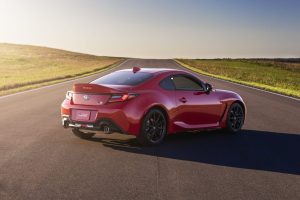
The good news is there’s no ASS – automatic stop/start “technology.” The boxer engine stays on until you turn it off.
Most of the other stuff can be turned off or at least turned down, too.
The Bottom Line
It’s nice to have choices. Especially when both are great ones.
. . .
If you like what you’ve found here please consider supporting EPautos.
We depend on you to keep the wheels turning!
Our donate button is here.
If you prefer not to use PayPal, our mailing address is:
EPautos
721 Hummingbird Lane SE
Copper Hill, VA 24079
PS: Get an EPautos magnet or sticker or coaster in return for a $20 or more one-time donation or a $10 or more monthly recurring donation. (Please be sure to tell us you want a magnet or sticker or coaster – and also, provide an address, so we know where to mail the thing!)
If you like items like the Baaaaaa! baseball cap pictured below, you can find that and more at the EPautos store!



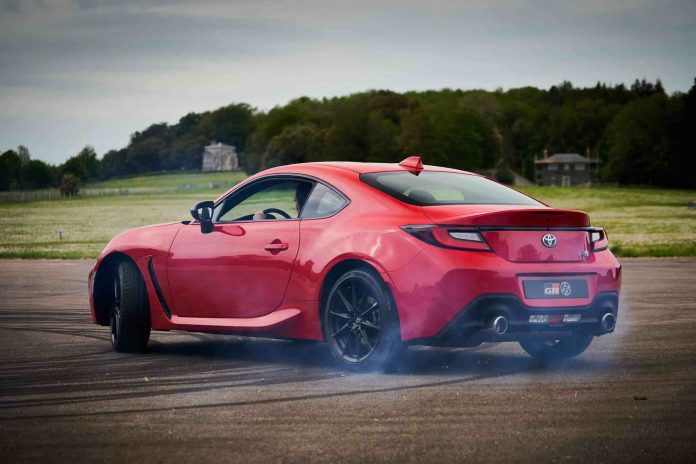


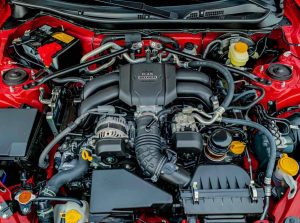








These Subaru 4 cylinder engines were bad…now they got worse with direct injection…..but…it would be worse if turbocharged…..
You can expect all sorts of issues related to that….and a short life span….
Direct injection is ruining the gas engines….driven by regulations related to bs emissions and fuel economy….
3 Big Problems With Direct Injection Engines (Gasoline)
https://www.youtube.com/watch?v=uVd-ZS5bnyY
Watch this and see why there is so many engine failures now…..
don’t buy direct injection gas engines….diesels are fine….diesel…the best engine…..
Since it has a manual, I’ll drop this here.
My daughter went out with some friends yesterday. One of whom received a truck with a stick shift from his uncle.
She came home last night smiling and raving about how she learned how to drive a manual.
The excitement that brought her goes to show that being able to control your vehicle is better than a trip to the circus. Of course that could have something to do with them turning doughnuts and slaloming the speed bumps in the local strip mall parking lot too.
It’s sad we’re a couple years away from there being NO new cars any of us would want to daily drive.
Personally I would never own anything that’s steer by wire or has motors hooked up to the wheel, that could theoretically nudge me into a ditch due to a malfunction or hack or EMP.
or anything brake by wire.
I’d also never own anything that the traction control / stability control / abs can’t be made non-functional if desired and still be alllowed(italics) to operate the vehicle.
Toyota isn’t stupid. They still make the old 4 runner for sale in upside-down land. They make cars people want (italics) to buy for as long as people are allowed (italics) to buy them.
General rule of thumb when you have time to type on the internet, think about why.
Great articles here lately Eric, keep it up!
Thanks for the kind words, Steve!
I agree re Toyota. It would be really eye-opening if more people knew about the $13k HiLux Champ you can’t buy here.
I would buy the new Toyota Hilux Champ/Stout in a heartbeat if it was sold in the USA, a Tacoma Tundra no way.
2023 was the last year of the Challengers, Chargers, and V8 Tundras. And 2024 is the last year of the unaided V6 Tacomas.
Other than 3/4 ton trucks, I’d say we’re there now.
Too bad about the cheesy all-digital drivers display.
I deplore having digital numerals — e.g., 48 MPH — flashing at me, as opposed to a mechanical needle on a gauge which one can attend to or ignore as desired.
This car would be a monster with a turbo. I’m a speed freak. It is why the Miata was never my jam. A FUN car for sure, just not for me. I suppose I could always aftermarket it, but it is a shame they don’t offer it factory. My understanding is this car unlike say a MKIV Supra is a car where stock internals simply cannot support the extra HP. So it gets quite pricey if you start trying to make this car fast and do not upgrade the -other- stuff to support it.
https://www.grperformanceparts.com/hks-bolt-on-turbo-kit-gtiii-rs-kit-for-the-gr86-brz-2022/
https://store.worksmotorsports.com/WORKS_2022_BRZ_GR86_Stage_2_Turbo_Kit_p/142.222.htm
They should offer a factory turbo, this is a modern day Silvia (240sx), and the S15’s had the SR20DET’s (2.0t back when it was cool to have a 2l turbo)
Imagine a FA20/24 for the BRZ, Brz wrx, that would be fun!
Hi Useranon99,
I don’t know this for certain, but I think the naturally aspirated 2.4 in the GR86/BRZ is the same basic engine as the turbocharged version of this engine that’s used in the WRX (where it makes 271 hp). A little more boost and some tuning and my guess is 320 hp would be easy to get out of this engine.
The owner took a Porsche 924 and added a turbo….the result….390 HP at the wheels…. Std n/a engine+,stage 1 cam, diy turbo setup, MaxxECU, E85, 2bar(29psi) boost,…2400 lb car….
A beast for very little money…..
These 924’s have a very strong 4 cylinder engine….if you boost a Miata engine like this it will break….GR/GT86….similar problem…
https://www.youtube.com/watch?v=JswzUStfehU
This is multiple times cheaper then a new GR86 or Miata…and better….a totally analog car….
Modified 924….A super charger works too…….
This Supercharged Porsche 924 Uses a Modified Eaton M45 From a Mini Cooper S!
https://www.youtube.com/watch?v=biVROE4WFDw
Blown Subaru BRZ / Scion FRS FA20 Boxer Engine Teardown. A $3,000 + Whoopsie.
https://www.youtube.com/watch?v=QLBFK1nUbf4
Eric, I think it would be cool if you did some in-depth retro reviews of classic cars. Reading this article, I enjoyed the comments about the Camaro and Firebird more than the comments about the (what was it?) Toyota.
Hi Philo,
I’d love to find a way to do that! The difficulty lies in finding the classic cars to test drive. I did think about asking the Duncan people about this, though.
You should! I bet it would be a big hit.
You could have a section where you list the pros and cons of using it as a daily driver today. Ease of repair, availability of parts, etc… Might encourage a few people to make that leap.
Make an info card to hand out at swap meets and car shows. Car guys would be ecstatic to have their car featured in an article. I know I would if you were closer.
You could find people who daily drive a classic and interview them, do a driver profile.
Just throwing these out there, hope you don’t mind…
Jack…an automotive journalist in England makes youtube videos of car test drives…people with interesting classic cars let him drive their cars and make a video of the test drive….
https://www.youtube.com/@Number27/videos
Another good one…
James at JayEmmOnCars….an automotive journalist in England makes youtube videos of car test drives…people with interesting classic cars let him drive their cars and make a video of the test drive….
https://www.youtube.com/@JayEmmOnCars/videos
Mat Watson at carwow is another one….
He is an automotive journalist in England who makes youtube videos of cars drag racing…1/4 mile and 1/2 mile..…people with interesting classic, performance and supercars let him drive their cars and make a video of the drag race….
https://www.youtube.com/@carwow/videos
One of the new cars Id actually consider, as the latest otherwise would be challengers and last gen Mustangs, with a Z thrown in
Any plans on the GR Corolla, Eric?
These cars are at least 10 years old in design, nice as they are.
That said, they could extend their life. Based on the EPA mileage figures, it appears that this thing is pretty short geared. It would be a lot better if the final drive was a little taller to relax the engine at highway speeds.
Long highway legs are the ingredients of efficiency.
If I was 20 years younger, I would consider it. Now the idea of squatting down that low to get in a car just has no appeal.
Being a long time driver of Miatas, getting in is easy, just point your butt at the seat and fall in. Getting out, on the other hand…….
That’s some driver assist technology I could get behind. One that lifts out your behind.
Hi axiomata,
Low-slung sports cars can be difficult for older (and heavier) people to get into and out of. Kind of like it’s harder to older/heavier guys to get into the pants that used to fit!